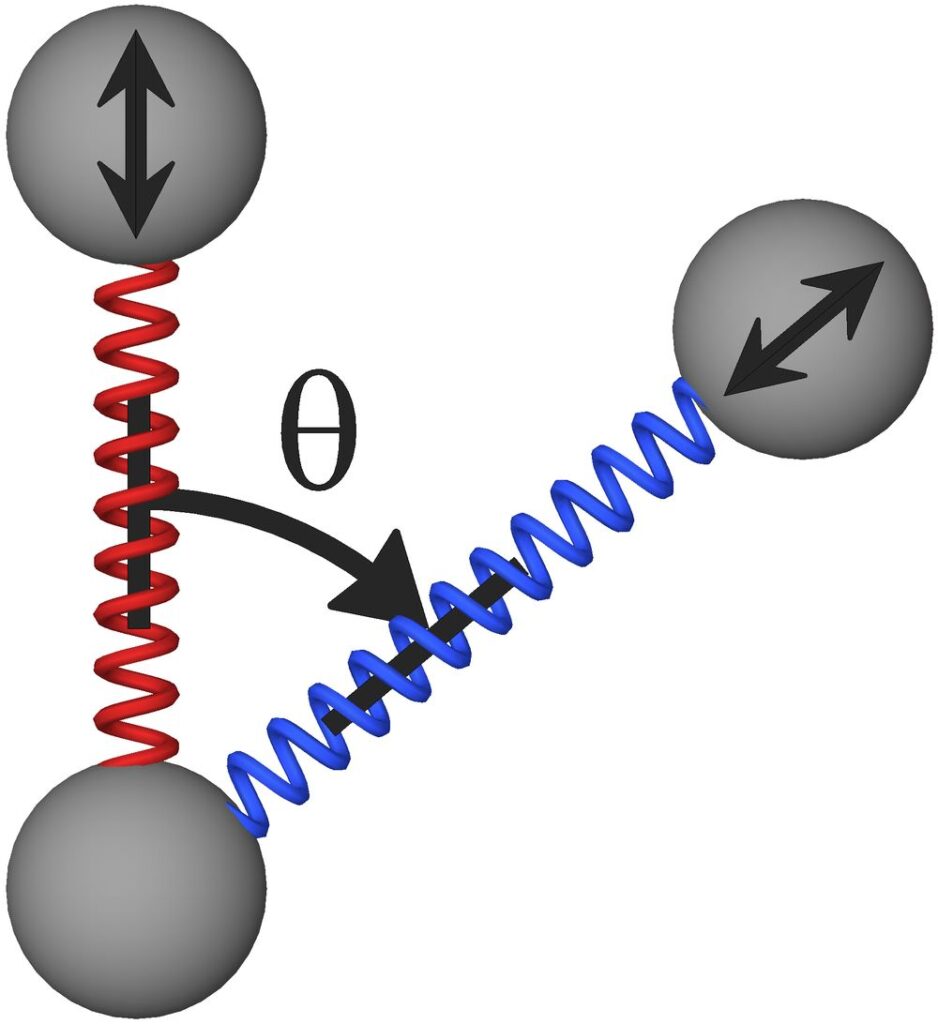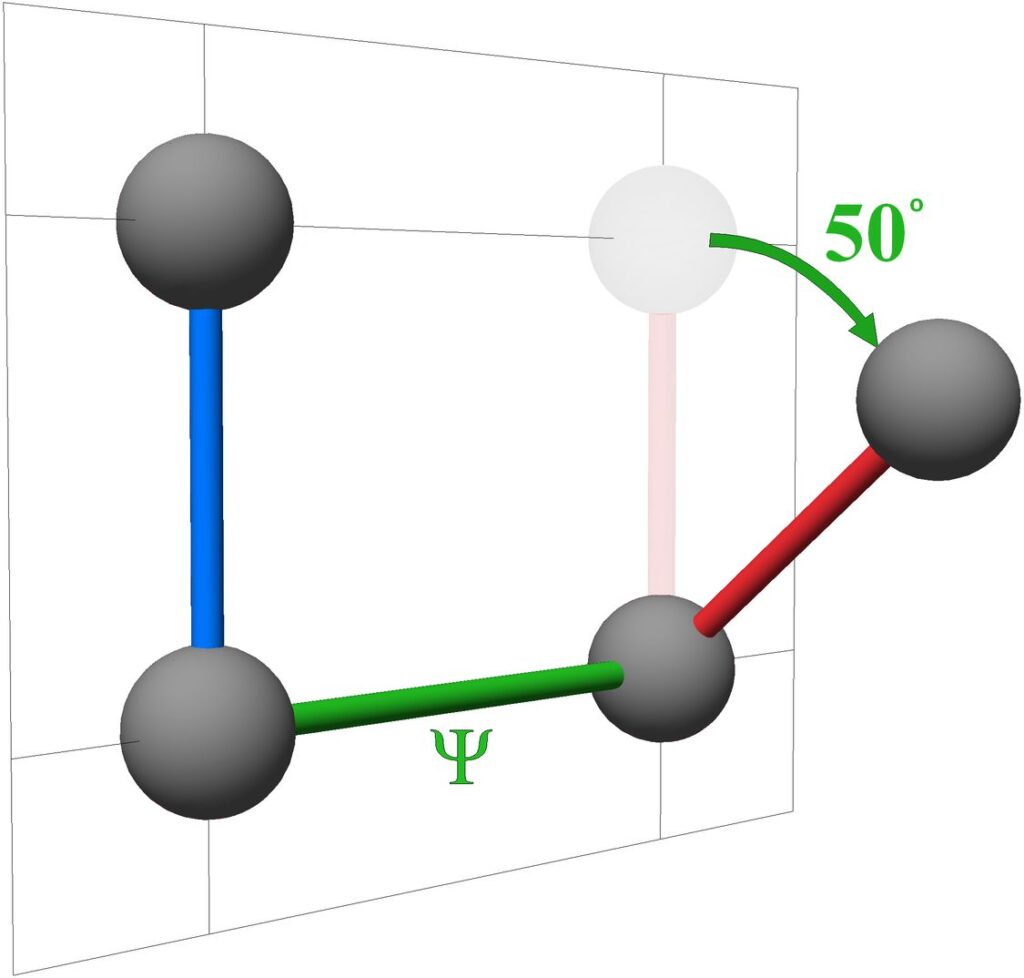Chapter 5
Molecular Geometry Locks
Direct Arrivals From a Google Search
If you arrived here directly from a Google Search, this website accepts free will as real and then integrates free will into physics. You may wish to read this brief overview for additional details.
The Length Lock
We continue seeking a way for minds to exert real forces that alter the course of physical events, but without doing any work or violating any of the conservation laws.
Consider a bond joining two atoms that are oscillating back and forth along the axis of the bond, as shown in Figure 5. We will assume that this bond is a living bond under the governing control of a mind.

Figure 5. Two bonded atoms vibrate along the axis of the bond.
Because the atoms are oscillating back and forth, they will come to rest twice during each vibrational cycle to reverse direction. In this scenario, we will apply our mind forces at a moment when the bond length comes to rest, as shown below in Figure 6. By applying inwardly acting mind forces when the atoms come to rest that exactly match the outwardly pushing bond force, the atoms will be held stationary and the energy of the system will remain constant.

Figure 6. The mind is applying a pair of inwardly directed mind forces to counter the outward force of the bond. The mind forces were initiated at the moment the bond length had reached a minimum. The forces of the mind are holding the two atoms in a fixed geometry.
In Figure 6, we now have a momentum-free mind exerting real forces on real matter in a way that changes real outcomes, but without doing any work. No work is being done by the mind forces when they continue to hold this lock because there is no relative motion between the atoms. The mind is changing the outcome because the mind forces are preventing the atoms from oscillating. And lastly, because no work is being done, we are not violating any of the conservation laws.
We will call this first geometry lock type a length lock because it is locking the length of the bond.
It is important to notice that the mind was able to impose the length lock above even though the bond was compressed and exerting a force on the atoms at the time the length lock was imposed. In other words, minds are able to store up useful potential energy by imposing geometry locks. Furthermore, geometry locks can be released at any time without violating any conservation laws.
This ability of the mind to store up useful potential energy and then release this energy at the time of its choosing will be key to understanding how myosin proteins manage the energy from ATP molecules. We will cover the details of how myosin proteins function in Chapter 13.
Length locks serve an even more important purpose, though. Length locks are ideally suited for carrying out communication between the amino acids within a protein, and for carrying out communication between different proteins. We will cover both in depth in later chapters.
The vibrating bond shown in Figure 5 could also have been locked when its length had reached a maximum. In this case, the bond would now be exerting an attractive force on the two atoms because the bond is stretched, so the mind forces would have to be outwardly directed to successfully hold the length lock, as shown in Figure 7.

Figure 7. These two atoms were at the distance of maximum separation and had stopped to turn around when the mind forces were first imposed. The stretched bond is pulling the atoms together while the mind forces oppose, so the length of the bond remains constant.
The stretched bond is shown in blue. (The color of each mind force matches the natural force it counters. Here, the mind forces are countering the attraction created by the blue bond, so the mind forces are blue.)
Again, as long as the mind forces locking the bond length are initially applied when the bond length is not changing, the mind forces will not violate the conservation laws. Mind forces needed for length locks are axial forces, that is, they are parallel to the bond axis.
The Planar Angle Geometry Lock
An angle formed by three points is called a planar angle. Planar angles are two-dimensional angles that can be represented on a flat piece of paper. Figure 8 shows two bonds forming the planar angle θ.

Figure 8. The red and blue bonds form planar angle θ. In Chapter 14, we will show that minds are able to exert the forces needed to lock planar angles without violating the conservation laws of physics.
In a planar angle geometry lock, the mind exerts forces to hold the planar angle constant. Understanding these forces requires some familiarity with physics, so we will cover planar angle locking forces in Chapter 14, “The Physics of Consciousness,” which is intended for readers with some physics background. However, until then, it is only important to know that a mind can use forces to lock planar angles without violating any of the conservation laws.
There is a characteristic angle for each planar angle within a molecule. Whenever the planar angle deviates from its characteristic angle, a natural restoring force will act on the atoms to bring them back to their equilibrium geometry. This natural restoring force makes planar angle geometry locks valuable for storing potential energy. In the last section, we found that length locks could be used to store potential energy, and this is also true with planar angle geometry locks.
The Dihedral Angle Geometry Lock
A dihedral angle is a three-dimensional angle formed by three bonds. Figure 9 shows dihedral angle Ψ. As seen in the figure, the three bonds forming the dihedral angle Ψ started out in the same plane, so at the starting time the dihedral angle was zero.

Figure 9. Three bonds are needed to form a dihedral angle. The dihedral angle represents how far the bond farthest from the viewer has been rotated out of plane.
The far bond was then rotated 50° about the axis of the green Ψ bond. This clockwise rotation created a dihedral angle of +50°. If the far bond had been rotated counterclockwise, the dihedral angle would have been -50°. The identity of a dihedral angle is assigned to the bond in the middle, so in Figure 9, the Ψ dihedral angle is +50°.
In Chapter 14, we will find that a mind can lock dihedral angles without violating the conservation laws. Locking a dihedral angle will require governing control over all three bonds that make up the dihedral angle. In Chapter 14, we will cover the forces needed to lock a dihedral angle. At that time, we will also find that a mind can lock only the dihedral angle, so the lengths of the three bonds and the two planar angles formed by the three bonds will all remain free to vary unless they have been locked independently.
Some dihedral angles do not have a characteristic angle, so they can rotate freely within an angular range. Without a natural restoring force, these freely rotating dihedral angles will not be useful for storing potential energy. However, we will find that dihedral angle geometry locks are useful for controlling protein folding and protein function. We will cover these topics in Chapter 10.
Experiencing Our Surroundings
Earlier, we found that the minderelle that each human calls me must be located at a command center somewhere within the brain. We also found that the mind must be able to exert forces on atoms, otherwise minds would not be able to change physical outcomes.
But we each experience consciousness, and we know from this experience that we can do more than randomly change outcomes. Before I choose one outcome over the many other possible outcomes, I first have knowledge of my surroundings and I am choosing outcomes based on this knowledge. This means that information about my surroundings is somehow being transferred from the physical world around me to the thoughts of my conscious mind.
Science already understands a great deal about the biological portion of this process. For example, we already know that our eyes collect visual information and that this visual information is processed by the brain. Then, based on what we have found so far, the brain is sending this information to the single conscious molecule located at the command center of the brain, the same molecule that gives each of us our consciousness.
It is this last step in the process that we are concerned with here. When this information finally arrives at the atoms of this one minderelle, how does this information make the seemingly magical jump into the thoughts of the conscious mind? We will discuss this transition from matter in motion to thoughts in progressively more depth as we continue, but we will start with a most basic presentation now.
Newton’s Third Law
Physics has always understood that only objects with momentum could exert forces on other objects. However, we have now found that massless and momentum-free minds can exert scientifically acceptable forces on material objects as well. Newton’s third law tells us that whenever one body acts on a second body, the second body exerts an equal and opposite action on the first body. This is often written as follows.
Newton’s Third Law:
For every action, there is an equal and opposite reaction.
We will now apply Newton’s third law to thinking minds. We have found that a mind can exert forces on the atoms of its minderelle. But if this is true, then the reciprocal must also be true. If the mind’s thoughts can exert forces on the atoms of its minderelle, then external forces acting on the minderelle must affect the thoughts of the mind.
In other words, a mind will be informed of its surroundings when the atoms of its minderelle are acted upon by external forces. We find that a mind experiences its surroundings through the information received by the externally caused motions of the atoms it governs.
Evolution and Biology
Because consciousness depends solely on the existence of a mind signature molecule, there is only one characteristic of life and it is this one molecular structure. This means that consciousness can exist without growth or reproductive capabilities, and it can exist without any need for energy or nutrition.
In fact, the conscious mind can exist and think independently of all biological complexity. Even if a mind signature were floating alone in empty space, it would still be fully alive and conscious in exactly the same way that each of us is alive and conscious. That is, our entire consciousness is the consciousness of a single mind signature molecule.
At this point in the discovery process, we have minds that experience their surroundings through the externally caused forces acting on their minderelles, and we also have the inverse, minds can act on their surroundings by exerting forces on their minderelles. Because minderelles can experience their surroundings, and because different surroundings will lead to different experiences, we now have thinking minds with an incentive to improve their living conditions and the capability of doing so. It follows that these molecular bodies of living matter will make free will choices to improve their living conditions.
Consistent with these findings, we find evolution to be the process of minderelles making free will choices to improve their living conditions and biology to be the product of this evolutionary process. In this free will paradigm, we find that all biological systems are the result of intelligent design, and the intelligent designers are us.